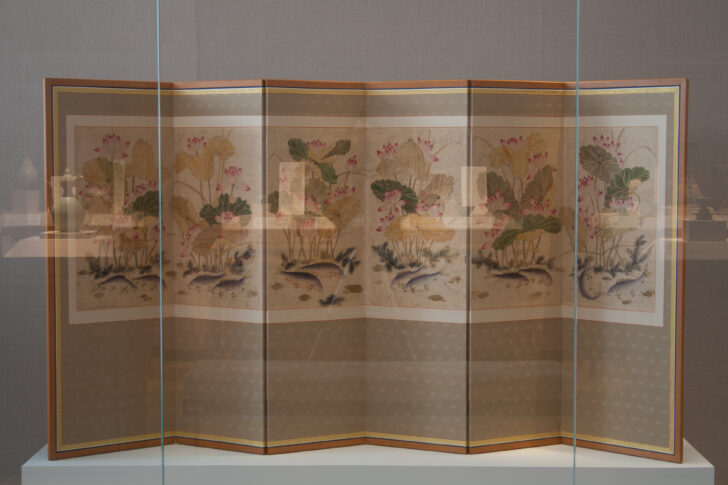Lotus and Carp
Korean

Description
Lotus and Carp
Korea
19th century
Six-panel folding screen, ink and color on paper
Museum purchase made possible by the Director's Acquisition
Committee, 2014/2.202
This screen from a woman’s room demonstrates the owner’s
aspirations for a happy marriage, many children, and her family’s
success. The two carp represent the couple and symbolize the
unification of yin (the female principle) and yang (the male principle).
The lotuses—plants that bear fruit and flowers at the same time—
signify fecundity and the hope that male members of the family
will pass the civil service examination required to become a
government official on the first attempt. This is because in Korean
the pronunciation of the characters for lotus fruit is yeon’gwa, which
is the same as the pronunciation of the characters for success on the
exam. In Korean folk art, a carp is also an emblem of successfully
passing the civil service exam.
Summer 2024 Gallery Rotation
____________________
Copies and Invention in East Asia (August 17, 2019 - January 5, 2020)
This screen demonstrates the owner’s aspirations for a happy marriage, many children, and her family’s success. The pair of carp represents the couple and symbolizes the unification of yin (the female principle) and yang (the male principle). The lotuses— plants that bear fruit and flowers at the same time— signify fecundity, as well as the hope that male members of the family will pass the civil service examination, which was required to become a government official, on their first attempt. This is because in Korean the characters for lotus fruit are pronounced yeon’gwa, which is also the pronunciation of the characters for success on the exam. In Korean folk art, a carp is also an emblem of successfully passing the civil service exam, so here this idea is expressed twice.
Lotus and Carp
Korea, Joseon period (1392–1910)
19th century
Six-panel folding screen, ink and color on paper Museum purchase made possible by the Director's Acquisition Committee, 2014/2.202
This screen from a woman’s room demonstrates the owner’s aspirations for a happy marriage, many children, and her family’s success. The pair of carp represents the couple and symbolizes the unification of yin (the female principle) and yang (the male principle). The lotuses— plants that bear fruit and flowers at the same time—signify fecundity. The lotus also expresses the hope that male members of the family will pass the civil service examination required to become a government official on the first attempt. This is because in Korean the pronunciation of the characters for lotus fruit is yeon’gwa, which is the same as the pronunciation of the characters for success on the exam. In Korean folk art, a carp is also an emblem of successfully passing the civil service exam. This screen from a woman’s room demonstrates the owner’s aspirations for a happy marriage, many children, and her family’s success. The pair of carp represents the couple and symbolizes the unification of yin (the female principle) and yang (the male principle). The lotuses— plants that bear fruit and flowers at the same time—signify fecundity. The lotus also expresses the hope that male members of the family will pass the civil service examination required to become a government official on the first attempt. This is because in Korean the pronunciation of the characters for lotus fruit is yeon’gwa, which is the same as the pronunciation of the characters for success on the exam. In Korean folk art, a carp is also an emblem of successfully passing the civil service exam.
Subject Matter:
The lotus flower, which emerges pristine from muddy surroundings, is the Buddhist symbol of purity, creation, and birth, and it often appears in Buddhist painting, sculpture, and architecture. Pairs of carp, signifying marital harmony and fertility, swim below the water. The Chinese word for lotus is a partial homonym with “harmony” and “union,” suggesting that this screen may have been commissioned for a wedding.
Physical Description:
A six panel folding screen depicting pairs of carp on each of the lower portions of each panel, and lotus blossoms.
Usage Rights:
If you are interested in using an image for a publication, please visit https://umma.umich.edu/request-image/ for more information and to fill out the online Image Rights and Reproductions Request Form.